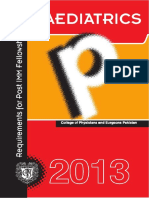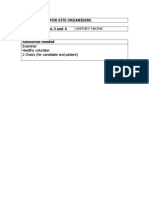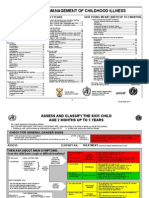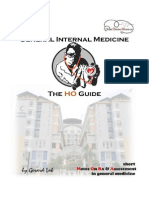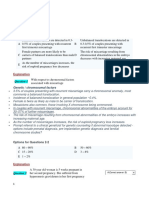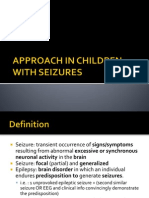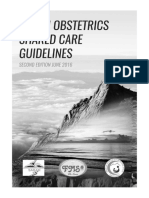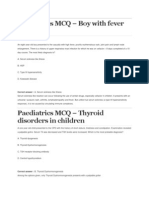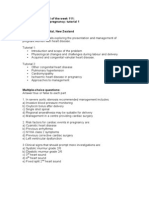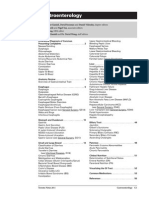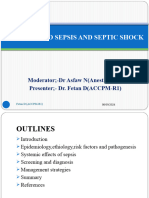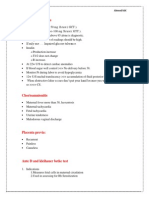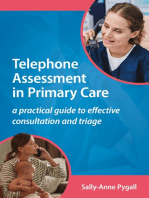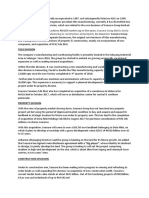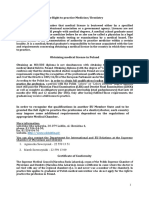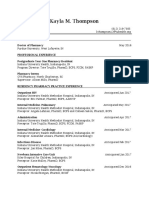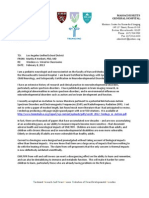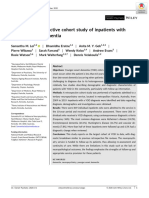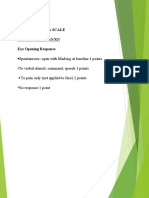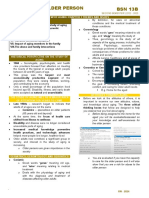0 ratings0% found this document useful (0 votes)
637 viewsO and G Ho Book
O and G Ho Book
Uploaded by
Ahmad Mustaqim SulaimanThis document provides guidelines for obstetrics and gynecology duties at a hospital. It includes sections on patient assessment, labor and delivery, common ward problems, and the gynecology-oncology ward. Shift schedules and duties are outlined for locations like the labor delivery suite, patient assessment center, and various wards. Clinical areas covered include obstetric examinations, ultrasound, managing labor, common postpartum issues, and oncology treatments. Abbreviations commonly used in obstetrics and gynecology are defined. The document is intended as a quick reference for hospital protocols and managing patient care areas in obstetrics and gynecology.
Copyright:
© All Rights Reserved
Available Formats
Download as PDF, TXT or read online from Scribd
O and G Ho Book
O and G Ho Book
Uploaded by
Ahmad Mustaqim Sulaiman0 ratings0% found this document useful (0 votes)
637 views48 pagesThis document provides guidelines for obstetrics and gynecology duties at a hospital. It includes sections on patient assessment, labor and delivery, common ward problems, and the gynecology-oncology ward. Shift schedules and duties are outlined for locations like the labor delivery suite, patient assessment center, and various wards. Clinical areas covered include obstetric examinations, ultrasound, managing labor, common postpartum issues, and oncology treatments. Abbreviations commonly used in obstetrics and gynecology are defined. The document is intended as a quick reference for hospital protocols and managing patient care areas in obstetrics and gynecology.
Original Description:
ampang o n g guideline
Original Title
o and g ho book
Copyright
© © All Rights Reserved
Available Formats
PDF, TXT or read online from Scribd
Share this document
Did you find this document useful?
Is this content inappropriate?
This document provides guidelines for obstetrics and gynecology duties at a hospital. It includes sections on patient assessment, labor and delivery, common ward problems, and the gynecology-oncology ward. Shift schedules and duties are outlined for locations like the labor delivery suite, patient assessment center, and various wards. Clinical areas covered include obstetric examinations, ultrasound, managing labor, common postpartum issues, and oncology treatments. Abbreviations commonly used in obstetrics and gynecology are defined. The document is intended as a quick reference for hospital protocols and managing patient care areas in obstetrics and gynecology.
Copyright:
© All Rights Reserved
Available Formats
Download as PDF, TXT or read online from Scribd
Download as pdf or txt
0 ratings0% found this document useful (0 votes)
637 views48 pagesO and G Ho Book
O and G Ho Book
Uploaded by
Ahmad Mustaqim SulaimanThis document provides guidelines for obstetrics and gynecology duties at a hospital. It includes sections on patient assessment, labor and delivery, common ward problems, and the gynecology-oncology ward. Shift schedules and duties are outlined for locations like the labor delivery suite, patient assessment center, and various wards. Clinical areas covered include obstetric examinations, ultrasound, managing labor, common postpartum issues, and oncology treatments. Abbreviations commonly used in obstetrics and gynecology are defined. The document is intended as a quick reference for hospital protocols and managing patient care areas in obstetrics and gynecology.
Copyright:
© All Rights Reserved
Available Formats
Download as PDF, TXT or read online from Scribd
Download as pdf or txt
You are on page 1of 48
THE OBSTETRICS & GYNAECOLOGY HO GUIDE
Compiled Dr Gerard Loh,
Special Thanks Dr Liew Nyan Chin, Dr Rosalina Ali
Dr Murali, Dr Low Wea Haw, Dr Lavitha, Dr Ranjit, Dr Maiza, Dr Shilpa, Dr Liza
Dr Wong JC, Dr Yusnira, Dr Rosvin, Dr Suri, Dr Komal, Dr Mimi, Dr Che Hasnura,
Dr Mashar, Dr Sharmina, Dr Bahijah, Dr Fauziah, Dr Saleha
and to fellow colleagues , Sisters, SN and JM who taught me so much!
CONTENTS
1. Patient Assesment Centre
- Obstetrics/Gynae Clerking
- Table of common problems
- Obstetric Examinations
- Cardiotocography
- Obstetric Ultrasound
2. Labour Delivery Suite
- Partogram
- Labour Augmentation
- Artificial Rupture of Membrane
- Episiotomy and repair
3. Common Ward Problems and Management
4. The Gynae Onco Ward
- Oncology and Chemotherapy
Places of duty
Labour Delivery Suite + HDU
Patient Assesment Centre
Wards Antenatal, Postnatal, Gynae-Onco, NICU/Paeds
OT ELLSCS Mon-Fri, Gynae Tues,Thurs
Clinic
Shift system AM PM ON
LDS
PAC
7am-6pm weekdays
7am-2pm Saturday
11am-11pm weekday
10am-11pm weekend
10pm-10am
* 2 HOs to clinic next
morning on Mon/Wed/Fri
4D Antenatal ward
4C Postnatal ward
6A Gynae-Onco ward
7am-6pm weekday
7am-11am weekend
(Grp in charge of ward)
7am-2pm Saturday
11am-11pm weekday
10am-11pm weekend
(4D+4C) (6A)
10pm-10am
Wards 4D / 6A 1 Group will be in charge
of wards every 2 weeks
*2 HOs goes to clinic
- 10am-2pm (review
mothers in 4A+NICU)
- 2pm-11pm ( ward)
*both ward HOs to 4C
next morning 7am-10am
* ward HOs must do night
review for 4C
* tends to change from time to time
This compilation of short notes is intended only as a quick reference guide.
Always refer to your hospitals own protocol for the full plan and management i.e HA O&G protocol
May this guide assist you in your O& G Posting! Special thanks to Dr Liew for assisting me in this project. Your kindness will be
remembered by us all.
Gerard Loh Chien Siong
M.D., CSMU, Ukraine
O&G Posting March-June 2012
More: HOW O&G guide part 1 available on www.myhow.wordpress.com
Abbrevations
1. AC abdominal circumference
2. AFI amniotic fluid index
3. AFP Alpha feto protein
4. ACL Anticardiolipin antibody
5. AID artificial insemination of husbands
sperm
6. AID artificial insemination of donors sperm
7. ANC antenatal clinic
8. APH antepartum hemorrhage
9. APS antiphospholipid syndrome
10. ARMartificial rupture of membrane
11. A&W alive n well
12. ACHafter coming head
13. BBA born before arrival
14. BOH bad obs history
15. BPD biparietal diameter
16. BPPbiophysical profile
17. BSO Bilateral salphingoophorectomy
18. BTL bilateral tubal ligation
19. BSP blood sugar profile
20. CCT controlled cord traction
21. CIN cervical intraepithelial neoplasia
22. COCP combined oral contraceptive pills
23. CRL crown rump length
24. CTG cardiotocograph
25. Cx cervix
26. CRNcord round neck
27. CEA carcino embryogenic antigen
28. c/o complaint of
29. DD&C diagnostic dilatation n curettage
30. DVT deep vein thrombosis
31. d/w discuss with
32. D&C dilatation and curettage
33. DIVC disseminated intravascular coagulation
34. DUB dysfunctional uterine bleeding
35. DCDAdichorionic diamniotic
36. DCMA Dichorionic monoamniotic
37. ECV external cephalic version
38. EDD estimated date of delivery
39. EFW estimated fetus weight
40. EL LSCS elective lower segment Csection
41. EM LSCS emergency lower segment Csection
42. ERPOC evacuation of retained products of
conception
43. ERT estrogen replacement therapy
44. E2 estradiol
45. EUA examination under anaesthesia
46. EBL estimated blood loss
47. FL femur length
48. FKC fetal kick chart
49. FSB fresh still birth
50. FHfetal heart
51. FHHfetal heart heard
52. FHNH fetal heart not heard
53. FHHR fetal heart heard regular
54. FM fetal movement
55. GDM gestational DM
56. GS gestational sac
57. G gravida
58. GnRH gonadotropin releasing hormone
59. GBS group B streptococcus
60. HC head circumference
61. hCG human chorionic gonadotropin
62. HRT hormone replacement therapy
63. HSG hysterosalphingogram
64. HbA1c glycosylated Hb
65. HVS high vaginal swab
66. Hystrec hysterectomy
67. HGSILhigh grade squamous intraepithelial
lesion
68. HPV human papilloma virus
69. h/o history of
70. IE impending eclampsia
71. IGT impaired glucose tolerance
72. IOL induction of labour
73. ISD interspinous diameter
74. ITD intertuberous diameter
75. IUCD intrauterine contraceptive device
76. IUI intrauterine insemination
77. IUDintrauterine death
78. IUGS intraunterine gestational sac
79. IUGR intrauterine growth restriction
80. I&D incision and drainage
81. Ix investigation
82. IVF in vitro fertilization
83. KIVkeep in view
84. KK klinik kesihatan
85. LA lupus anticoagulant
86. Lap & Dye laparascopy and dye insufflation
87. LAVH Laparascopic assisted vaginal
hysterectomy
88. LMSL light meconium stained liquor
89. LNMP last normal menstrual period
90. LPC labour progress chart
91. LOA left occipito anterior
92. LOP left occipito posterior
93. LOT left occipito transverse
94. LH luteinizing hormone
95. LBW low birth weight
96. LGSIL low grade squamous intraepithelial
lesion
97. MA membrane absent
98. MOGTT modified oral glucose tolerance test
99. MI membrane intact
100. MMSL moderately meconium stained liquor
101. MOD mode of delivery
102. MMG mammogram
103. MRP manual removal of placenta
104. MSB macerated stillbirth
105. OCP oral contraceptive pills
106. OA occipito anterior
107. OP occipito posterior
108. OT occipito transverse
109. OI ovulation induction
110. o/e on examination
111. PA placenta abruptio
112. PCOS polycystic ovarian syndrome
113. PE preeclampsia/ pulmonary embolism
114. PE chart preeclampsia chart
115. PFR pelvic floor repair
116. PID pelvic inflammatory disease
117. PIH pregnancy induced hypertension
118. PNC postnatal clinic
119. POA period of amenorrhea
120. POC product of conception
121. POD pouch of Douglas
122. PMB postmenopausal bleeding
123. POG period of gestation
124. POP progesterone only pills
125. PP placenta previa
126. PPH postpartum hemorrhage
127. PROM premature/prelabour rupture of
membrane
128. PPROM preterm premature/prelabour
rupture of membrane
129. PV per vaginal
130. P/A per abdomen
131. P para
132. REDD revised expected date of delivery
133. ROA right occipito anterior
134. ROP right occipito posterior
135. ROT right occipito transverse
136. Re review
137. RPC retroplacental clot
138. S&C suction and curettage
139. SE speculum examination
140. SFH symphysiofundal height
141. SGA small for gestational age
142. SPA suprapubic angle
143. SROM spontaneous rupture of membrane
144. St station
145. SVD spontaneous vertex delivery
146. SOD sure of date
147. s/b seen by
148. STO suture to open
149. SCC squamous cell carcinoma
150. STD sexually transmitted disease
151. STI sexually transmitted infection
152. Synto syntocinon
153. TAHBSO total abdominal hysterectomy with
bilateral salphingoophorectomy
154. TAS transabdominal scan
155. TCA to come again
156. TLH total laparascopic hysterectomy
157. TOS trial of scar
158. TOP termination of pregnancy
159. TVS transvaginal scan
160. TMSL thick meconium stained liquor
161. UV prolapsed uterovaginal prolapse
162. Ut uterus (UtTS: uterus at term size)
163. UPT urine pregnancy test
164. USOD unsure of date
165. VBAC vaginal birth after Caesarean
166. VE vaginal examination
167. V/v vulva/vagina
168. Vx vertex
PAC (Patient Assessment Centre)
s/b or d/w ___ (Medical officer/specialist)
Obstetrics Clerking
Age/Race:
Gravidity, parity (G1P0) @ Gestation age: @ weeks + days by
POA/POG/REDD
Dates: SOD/USOD, Menses: previously regular/irregular menses,
Contraception: IUCD/barier/OCP?
Scans: Earliest scan @ __weeks, subsequent scans corresponds to date
Verification of dates
The most accurate parameter for dating is the CRL. If this is unavailable the earliest scan is used. The LMP is used to calculate POA
Allowed discrepancy= 1
st
Trimester ~1 week (4/7) , 2
nd
Trimester ~2weeks(9/7) , 3
rd
Trimester~ 3weeks
* if USOD: early scan @ ~ 10 weeks,if >1 weeks discrepancy, REDD shld be given
if REDD was given earlier, use it to calculate POG
Marital status: SMS/2
nd
union
Conception- spontaneous/ artificial/subfertility
ANC: (PIH/PE/GDM/ANEMIA/UTI/URTI/Candidiosis / history of abortion..etc) or uneventful
c/o or referred from KK/GP for.
Otherwise
no show,
no LL,
no UTI,
no fever,
no contraction pain
good FM
Early pregnancy problem: (check antenatal book pink book)
-booking date @ weeks, @ KKIA _____
-booking BP__ , remains normotensive throughout pregnancy ranging ___
-Booking Hb__, anemic? Latest Hb__
-MGTT done? (indication: family hx, age >35, excessive weight gain, prev macrosomia/GDM/fetal abnormalities)
-Albuminuria/glycosuria?
-Blood Group / Rhesus (if NEGATIVE, any Rhogum given, @ __weeks
-Infections screening done? (VDRL/HIV screening) Not reactive
Past Obstetric hx:
year, mode of delivery, hospital, baby sex, weight , any complications?
* if spacing >5years- why? Voluntary? Diff union?
* Pay attention to prev scar, indication of LSCS, counselling for VBAC
*post partum: fever/prolonged stay in ward/ wound breakdown/PPH/blood transfusion?
Medical/surgical history
- known medical illness or surgeries ( asthma, thyroidism, DM, HPT etc)
Social Hx: marital status (married/SMS/2
nd
union), occupation, husbands occupation, smoker/alcohol, type of house/rented/own resident
Clinical Assesment
General: alert, conscious, not pale, non tachypnoic, hydration fair
Systemic: lungs clear, CVS DRNM, Thyroid NAD (goiter), Breasts NAD (cyst/engorged/mass)
Pa: soft, non-tender, singleton, uterus @wks, cephalic ?/5, EFW, scars?
Speculum: (if indicated: LL, PV bleed/prem cx)
Cervix healthy (ectropion/fibroid), cough test +/- Litmus test, pooling of liquor, os closed,
* any discharge (white curdy/pus)- take High Vaginal Swab (Mandatory if pt is subjected to speculum)
Ve: VV normal (varicosity, vesicles,cysts..etc) , Os dilation, Cervix effacement, Station,
Vertex, membrane intact/absent, no cord/placenta
u/s: Presentation, Lie, Placenta Site, AFI, EFW, CGA , parameters BPD, FL, AC, HC
CTG: Define risks, Contractions, Baseline Fetal Heart Rate, Variability, Acceleration, Deceleration (refer to CTG section)
Impression: summary of problem (25 yo malay lady, G1P0 @ 38 weeks, Imp: active phase of labour)
Management:
1
st
Trimester 1-12
2
nd
Trimester 13-27
3
rd
Trimester 28-42
Term = 37- 40 weeks
Preterm = <37 weeks
Viable = 22weeks
EDD = 40wks
EDD + 9/7, post dates not allowed for GDM, PIH, PE
Common problems, assessment and management
C/O Clinical assessment
Lower abd pain
- intensity
-frequency
a/w show/LL?
1) PA
2) VE
3) CTG
* Primid Os closed/TOF/< 3cm = allow home if nearby+ transport
available
*>3cm = for admission
Ddx = stones, appendicitis, AGE
Leaking liquor
-since @ time
- hx/clinic suggestive?
- character, density (Clear?)
- gushing/dribbling/?urine
- soak pants/spots
- used pads?
1) PA
2) Speculum + HVS
3) VE
4) CTG
5) Scan AFI
* if hx and clinically demonstrablePPROM/PROM?
* if not Hx suggestive, clinically not demonstrable, admit for pad chart|
Start antibx after 18hrs, if not delivered, KIV IOL if >24hrs
w/o for signs of chorioamnionitis fetal and maternal tachycardia, fever,
meconium, WCC elevated
Show
- @ time
- mucous+blood a/w abd pain?
- a/w leaking liquor?
- pad soaked/spotty
1)PA
2) speculum/VE
3)CTG
* Primid Os closed/TOF/< 3cm = allow home if nearby+ transport
available
*>3cm = for delivery
Ddx = PV bleeding
PV bleed
- @ time, a/w pain?
- spotty/stain/soaked
- trauma? Any POC
- scans/placenta
1) PA
2) Speculum
3) CTG (>34/52)
* > 22weeks TRO Placenta praevia / acreta (detailed scan)
* < 22weeks TRO miscarriage
* if indeterminate APH, do not allow post dates
Ddx = cervical ectropion
Discharge
- colour, smell
- amount, using pad?
- -dysuria, itchy, fever?
- ? LL
1) PA
2) speculum + HVS
3) UFEME
Curdy white = vaginal candidiasis. Treat with canestan pessary I/I ON
UTI symptoms
- dysuria, burning
- frequent urgency
-fever
1) UFEME (Leu/nitrate +)
2) Urine C & S
Start antibiotics (T. Cephalexin 500mg TDS 1/52)
ural I/I sachet tds 3/7
Reduced FM
- correct FKC? 9am-9pm
- usual time of completion
- ANC prob? h/o trauma?
- h/o UTI/candida?
1) PA
2) scan FH/FM
3) CTG (>34/52)
Observe 1 day FKC in ward (case to case basis)
Teach correct method of recording FKC
if persistently reduced and at term, consider IOL
High BP
- 1
st
episode @ wk
- on Rx?
- h/o hyptertn prev pregnancy
- signs of IE
Blurring of vision, headache,
giddiness, epigastric pain,
reflexes brisk, clonus
Repeat BP manual if >140
Adalat 10mg stat then,
monitor BP hrly
Admit for BP monitoring
Daily urine albumin
24hr Urine protein
UFEME
PE profile
BP monitoring in ward
PIH Hypertension in previously normotensive mother
PE Edema + Proteinuria + Hypertension
w/o signs of IE blurring of vision, brisk reflexes, clonus, edema,
proteinuria
Eclampsia EPH + tonic/clonic seizures
GDM
- dx @ wks
- diet control/insulin
- latest MGTT/BSP
- EFW, last scan
MGTT/BSP
Scan
plot growth chart
HbA1C(?Preexisting DM)
If poor diet control, 7 point BSP KIV insulin if deranged
Do not allow post date
detailed scan for fetal abnormalities/macrosomia
opthalmo appointment
refer dietician
Prem contraction
- @ wks
- frequency
- h/o UTI/candida?
- dexa given?
Scan
Time contraction
CTG
< 34weeks, consider tocolysis
34-37weeks, allow labour if progress (d/w MO)
IM Dexamethasone 12mg x 2 doses 12 hrs apart
T. EES 400mg tds for 5/7
Anemia
- Hb @ wks, latest
- on hematinics/obimin
- hx transfusion?
1) anemic signs
2) FBC (Hb/MCH/MCV)
3) Anemic profile (Fe)
4) scan
5) * FBP/Hb Analysis
Scan for fetal abnormalities
Determine type of anemia (IDA, B12/Folate deff/thalasemia etc)
Rhesus Negative
- Gravidity/parity
- husband/prev baby Rh
1) GSH
2) Coombs test
* Rhogam at 28wks and 34weeks, and within 72hrs post partum
Thyroidism
- dx @ wks
- hypo/hyperthyroidism
- on medication?
1) thyroidism signs
2) TFT
Hypo = L-Thyroxine
Hyper PTU
Carbimazole after d/w endocrinologist(under combine clinic every last
Thursday of the month)
The Antenatal Book (pink book) from KKIA
STICKERS
Under the WHITE code: (case suitable for home delivery - provided
trained birth attendant is present)
1. Gravida 2-5
2. No previous obstetric problems
3. No medical conditions like anemia, hypertension, Diabetes, heart
diseases, Tuberculosis, Asthma.
4. No complications in the present pregnancy
5. Cephalic presentation
Under the GREEN code: (Refer cases to public health nurses)
1. Maternal age: Primigravida: <> 35 years old and Multipara: 40
years old and above
2. Gravida 6 and above
3. Birth interval of less than 2 years or above 7 years
4. Mothers with special problems, e.g. psychiatric, handicapped,
single parent
5. Height <>
6. Unsure of dates
Under the YELLOW code: (Refer to doctor at healthcare centre or
hospital)
1. Rhesus negative
2. Hb <>
3. Dyspnea on exertion
4. Urine albumin 1+
5. Multiple pregnancy
6. Decreased fetal movement
7. Obesity >80kg
8. Drug addiction
Under the RED code: (Immediate hospital admission)
1. Severe pre-eclampsia
2. Eclampsia
3. Antepartum haemorrhage
4. preterm labour <>
5. Meconium stained liquor
6. Cord prolapse
7. Retained placenta
Management of common problems
In Active Phase Of Labor
Transfer to LDS
-plot partogram
- VE on strong contraction /bearing down
- Time contraction in 2hrs, if suboptimal for augmentation as per protocol
- IVD 4pints HM/24hrs
Cont central CTG monitoring with 2hrly intermittent tracing
offer entonox
IM pethidine 75mg + IM phernegan 25mg if CTG reactive
Latent phase of labour
admit ward 4D
CTG daily
FKC
LPC/ FHR 4hrly
VE on Strong contraction/ bearing down/ or LL
FBC, GSH
****************************************************
PROM/Leaking Liqour
admit ward 4D
-FBC / GSH / HVS
-LPC / FHR 4hrly
-strict FKC
-CTG daily
-strict pad chart - to inform if greenish discharge
-watchout for s/s of chorioamnionitis
-start IV ampicillin 2g stat, if not delivered after 18hr @ __H,
then 1g QID
-KIV IOL if not delivered after 24hr
* if allergic to penicillin - clindamycin
**************************************
Reduced FM
admit ward 4D
FBC / GSH
LPC / FHR 4hrly
strict FKC
CTG daily
if persistently reduced FM, KIV IOL
**************************************
Premature contraction for tocolysis
admit HDW
FBC / GSH / HVS / UFEME
LPC / FHR 4hrly
strict FKC
T. adalat 20mg in 4 doses every 15mins
IM dexa 12mg stat then 12hr later
book ventilator
**************************************
False labour
Allow home with reassurance
TCA stat if abdominal pain/LL/PV bleed/foul smelling discharge
TCA at EDD +9/7 for IOL if not yet delivered
* GDM/PIH/PE/Indeterminate APH cannot allow post dates
**************************************
Vaginal Candidiosis
Allow discharge with medication
Canesten pessary 500mg ON 1/7
TCA 2/52 clinic to review HVS
TCA stat if abdominal pain/fever/foul smelling discharge/PB bleed
UTI
Allow discharge with medication
HVS/UFEME/Urine C&S taken-to trace
T.Cephalexin 500mg tds x 1/52
Sachet Ural 1/1 TDS x3
Gynae Clerking (pregnancy <22 weeks + gynae problems)
Age/sex/race
K/c/o
LCB (last childbirth) \ ___ years
LMP/Menopause (how many years)
c/o: __
PV bleed
- pregnant?UPT done self/GP +?
- onset time, history, contraceptives?
- LMP, heavy? >flow than usual menses?
- heavy physical activity prior to onset?
- How many pads used?
- recent SI?
- a/w abd pain?
- passed out any POC?
Clots or fresh blood
Vital signs w/o hypovolemic shock
FBC/GSH
Sexually active UPT/ Beta HCG
Per Speculum
U/S TRO ectopic/miscarriage/fibroids/tumour
PAP smear TRO Ca
VE: Os open/closed
Miscarriage- observe, D&C/ERPOC
ectopic - diagnostic lap
Ectropion/Polyps/ molar pregnancy
Fibroids surgery/hormonal
Endometriosis review PAP smear
Cervix Ca - onco clinic
Menorrhagia/dysmenorrhea- hormone, clinic
Threathened miscarriage TCA 2/52 for U/S
or TCA stat if POC passed out, bring POC
Abdominal Pain/discomfort
- pregnant?UPT done self/GP +?
- onset time, history, contraceptives?
- location of pain, radiating?contraction?
- anemic sx? Fainting?giddiness?
- a/w PV bleed?
- a/w dysuria?PV discharge?
- abdominal distension? Mass?
Vital signs w/o hypovolemic shock
FBC/GSH
Sexually active UPT/beta HCG
PA: mass? Guarding?
U/S
ectopic: free fluid POD, empty Ut, ET thick
fibroids/ca/cyst = unusual mass
IUD= no FH/FM
UTI= suprapubic pain, itchy, dysuria
Miscarriage/ectopic/molar/IUD
Ovarian cyst/ cancer
Ddx: gastritis, appendicitis, renal colic,
cholelithiasis/cystitis/UTI
Admit for surgery
Oncology cases
- first presentation, hospital, symptoms
- PAP smear/sampling done?
- early and latest scans CT TAP/MRI
- surgeries TAHBSO/TLH/cystectomy etc?
- HPE results
- chemo/radiotherapy done?
- agent, line, cycle ?
CT TAP results
HPE results
Ca markers CA125, CEA etc.
Beta HCG/AFP - PTB
Surgery/chemo/radiotherapy
Admit for op/TCA onco clinic for counselling
Prechemo/pre op Blood Ix
Digitalize CT scans
Hyperemesis gravidarum
- onset, how many times per day
- ate outside?food poisoning?
- fever? Chills? Rigor?
- LOA, poor oral intake
- LOW?
- a/w diarrhoea/abdominal pain?
- character: food/bile/blood/projectile?
UFEME: Ket +, Nitrite+
RP :dehydrated picture
Loss of weight
DDx: nausea and vomiting in pregnancy,
AGE, food poisoning, gastritis/GERD
IVD 6 pints HM
Daily urine ketone
Vomit chart, I/O chart
IV Maxolon 10mg tds
IV ranitidine 50mg tds
Hyperemesis advice
GDM (<25 weeks)
sx same as obs
HbA1C to determine new or preexisting
MGTT
4 or 7 pt BSP
refer dietician
ophthalmo appt
Detailed scan appt
Miscarriage
1) Incomplete miscarriage
- evidence of retained POC
-heterogenous echogeneticity in uterus
Plan: ERPOC
2) Threathened miscarriage
- viable fetus, FH activity present
- measure CRL for dating
3) Missed miscarriage
- collapsed empty IUGS
TAS >25mm / TVS >20mm
4) Molar pregnancy
- no fetal pole- only vesicles
- snowstorm appearance
- Beta HCG
5) TRO ectopic pregnancy
- empty uterus
- presence of adnexal mass with free fluid
- take beta HCG
Per abdomen examination
1. soft non tender
2. Uterus @ __ weeks (SFH)
3) singleton, cephalic /5 (how many fingers in relation to symphysis pubis) 4-5/5 = ballotable/not engaged, <3/5 = engaged
4) Estimated fetal weight ( by experience)
Vaginal Examination
1. Vulva-vagina (check for abnormalities- varicosity, vesicles etc)
2. Os (determine this by measuring ones fingers)
3. Cervix dilation, consistency, , thickness, length, position (anterior, axial, posterior)
- both lips felt ~8cm , single lip felt ~ 9cm, no lips felt = fully
4. Station largest diameter of presenting part in relation to pelvic ischial spines
5. Vertex (head felt)
6. Membrane intact/absent- (slippery, balloon-like, bulging)
7. no cord/placenta felt (tubal structure, pulsatile, rough, soft)
Per Speculum Examination
Indication: leaking liquor, PV bleeding/discharge, prem
1. Os open/closed
2. Cervix healthy (ectropion/polyps etc)
3. Pooling of liquor a pool of liquor is demonstrable in the vagina
4. Cough test liquor leaks through cervix when cough
5. Litmus test liquor is more alkaline than urine
6. Curdy whitish discharge vaginal candidiosis
Always take High Vaginal Swab for C&S
The Obstetric Ultrasound
BPD: Measure outer table of the skull to the inner table.
HC: Meaure around the outer table of the skull.
AC: The abdominal circumference is taken with a transverse image to include the stomach, portal vein and the spine in a true
tranverse plane.
FL: The Femur length should only be measured when the femur is horizontal (beam is perpendicular) and shadows evenly- at least
from both ends.
AFI : Amniotic Fluid index (AFI)
Measure the deepest vertical pocket (with no foetal content) in each quadrant and add them together.
Placenta: Anterior/Posterior/Fundal/Lateral/Low
Dating
Mean Sac Diameter measurement is used to determine gestational age before a Crown Rump length can be clearly measured.The
average sac diameter is determined by measuring the length,width and height then dividing by 3 .
Once a fetal Pole can be visualised the CRL measurement is the most accurate method for dating the pregnancy
Presentation and position
Face presentation
Labour Delivery Suite
Consist of Labour Room + HDW
New Admissions
1. Review patient notes and history
2. Assess patient: vitals, PA
3. Perform ARM (if MI) as indicated. Note character of liquor. CBD
4. VE internal examination (Os, Cx thickness, location, Station, presenting part, cord/placenta)
5. start CTG, Plot partogram
6. Write details on the board + enter data into central CTG
7. Note time of next VE review
From Time In Name / AM Diagnosis Os Next VE To Do
4D/PAC 0600H Nguyen
AM00252332
G1PO @ 38/52 + 6/7
- PROM (LL <18hrs)
6cm
MI-ARM-CL
1000H
Tasks
1. ARM/VE review
2. Delivery/Episiotomy
3. Tear/episiotomy repair
4. Mother Post Natal review
5. Baby Post natal review
ARM (artificial rupture of membrane)
1. Make sure scans confirm placenta Upper segment
2. Perform VE, membrane intact (smooth, slippery balloon-like) or absent (rough, hair felt)
3. If MI, determine spot for ARM, a slight bulging, may be elicited by asking patient to cough
4. Position 2 fingers at this spot, insert amniohook between your 2 fingers, with hook facing down
5. Rotate hook upwards, using index finger, push the hook lightly against the membrane and slowly retract to rupture the membrane
6. A gushing of liquor indicates a successful ARM. Drain some liquor to examine its character
a) Clear Liqour
b) LMSL light meconium stained liquor watery brownish stained
c) MMSL - moderate MSL = watery with tiny particles visibile
d) Thick meconium minimal liquor, thick greenish/dark particles
Plan:
1. Plot Partogram
2. VE on strong contraction/leaking liquor/bearing down
3. Offer enthonox
4. IM Pethidine 75mg + IM phenergan 25mg if CTG reactive
5. Time contraction, if suboptimal for augmentation as per protocol
6. Continuous central CTG monitoring with 2hrly intermittent tracing
7. IVD 4pints HM over 24 hrs
Inform MO
- Suspicious/Pathological CTG (fetal brady, late decel, tachy)
- meconium stained liquor
- polyhydramnios for controlled ARM
- abnormal presentation, premature in labour
- Prolonged 2
nd
stage : Primid >1 hour, multipara >30-45mins
- Retained placenta
Inform Peds
- EMLSCS (reason, gestational age, EFW)
- Thick meconium
- Instrumental deliveries
- SGA/Macrosomic/Fetal abnormalities
- GDM on insulin
Plot Partogram
Time contraction, if suboptimal for augmentation as per protocol
Contractions
Mild 30secs
Moderate 30-45secs
Strong:>45secs
Optimal = 3-4 in 10mins
* hyperstimulation >4-6
Augementation
Post Natal Review
1) PA: Uterus well contracted
2) VE: Examine for any tear/laceration/active bleeding
3) evacuate blood clots
4) Examine sutures, any loose sutures, any gauze/tampon
5) Digital rectal exam: any sutures, anal tone intact
6) Any calve tenderness
7) lungs, CVS, vitals,
CTG
Dr C Bravado
1) Define Risks
2) Contractions ( 2:10, >5 -hyperstimulation
3) Baseline Rate (110-160bpm)
4) Acceleration
5) Variability
http://utilis.net/fhm/2459.htm
Decelerations
Decelerations
1. Early decel occurs with contractions (vaso-vagal response, fetal head compression)
2. Late decel occurs after contraction (utero-placental insufficiency)
3. Variable u shaped, not related to contraction (cord compression)
a) Early b) Late
c) Variable d) Prolonged
Episiotomy
1. Wait for crowning of the head, give LA
2. insert 2 fingers as shown, wait for thinning of the perineum
3. Cut at medio-lateral angle while patient is bearing down
4. Guard with tampon
Episiotomy Repair
1. Locate the apex of tear and begin suturing 1cm above this point
2. Apply continuous suture and end with knot at the fourchette
3. Next, apply interrupted suture in the muscular layer
4. Finally, apply interrupted suture to skin (Inside-out out-in)
Retained placenta
Failed CCT after > 30 mins, inform MO
- Intraumbilical IV pitocin 50U may help placenta separation sometimes
- if all fail, for MRP
PPH
- persistent bleeding occurring post partum EBL > 500 - 1000ml
Tone uterus muscle fatigue, over distension
Tissue retained placenta
Trauma tears, uterine rupture/inversion
Thrombin clotting disorder, ITP, HELLP syndrome, DIVC
Mx: massage uterus, if not well contracted, IV Pitocin 10U, check for any retained clots or placenta tissue
check BP if hypotensive, tachycardia, not responsive, pale,
- Set another IV line, Fluid resus, find source of bleeding, repeat FBC
- Observe in LDS for 1 hr, BP 1/4hrly until stable, strict pad chart to inform if PV bleed
- if tachycardia, BP persistently low, fever, admit HDW, KIV blood tx or inotropes
Cord prolapse = cord is felt, pulsatile
Cord presentation = cord felt, but membrane intact
1) determine gestation and viability ( <22 weeks or fetal abnormalities)
2) If viable, call for help (cord prolapse is NOT a red alert)
3) Keep finger in vagina, push head up to relieve compression
4) Tredelenberg position (bed foot raised)
5) Infuse 500ml NS in bladder (relieve compression)
6) ELSCS as indicated
(if anticipated cord prolapse, i.e polyhydramnios, check OT availability and inform anest)
Shoulder dystocia difficult delivery of shoulder
The HELPERR Mnemonic
H Call for help.
This refers to activating the pre-arranged protocol or requesting the appropriate personnel to respond with necessary equipment to
the labor and delivery unit.
E Evaluate for episiotomy.
Episiotomy should be considered throughout the management of shoulder dystocia but is necessary only to make more room if
rotation maneuvers are required. Shoulder dystocia is a bony impaction, so episiotomy alone will not release the shoulder.
Because most cases of shoulder dystocia can be relieved with the McRoberts maneuver and suprapubic pressure, many women
can be spared a surgical incision.
L Legs (the McRoberts maneuver)
This procedure involves flexing and abducting the maternal hips, positioning the maternal thighs up onto the maternal abdomen.
This position flattens the sacral promontory and results in cephalad rotation of the pubic symphysis. Nurses and family members
present at the delivery can provide assistance for this maneuver.
P Suprapubic pressure
The hand of an assistant should be placed suprapubically over the fetal anterior shoulder, applying pressure in a cardiopulmonary
resuscitation style with a downward and lateral motion on the posterior aspect of the fetal shoulder. This maneuver should be
attempted while continuing downward traction.
E Enter maneuvers (internal rotation)
These maneuvers attempt to manipulate the fetus to rotate the anterior shoulder into an oblique plane and under the maternal
symphysis. These maneuvers can be difficult to perform when the anterior shoulder is wedged beneath the symphysis. At times, it
is necessary to push the fetus up into the pelvis slightly to accomplish the maneuvers.
R Remove the posterior arm.
Removing the posterior arm from the birth canal also shortens the bisacromial diameter, allowing the fetus to drop into the sacral
hollow, freeing the impaction. The elbow then should be flexed and the forearm delivered in a sweeping motion over the fetal
anterior chest wall. Grasping and pulling directly on the fetal arm may fracture the humerus.
R Roll the patient.
The patient rolls from her existing position to the all-fours position. Often, the shoulder will dislodge during the act of turning, so
that this movement alone may be sufficient to dislodge the impaction. In addition, once the position change is completed,
gravitational forces may aid in the disimpaction of the fetal shoulders.
McRoberts position
ENTER Maneuver
Maneuvers of Last Resort for Shoulder Dystocia
Deliberate clavicle fracture
Direct upward pressure on the mid-portion of the fetal clavicle; reduces the shoulder-to-shoulder distance.
Zavanelli maneuver
Cephalic replacement followed by cesarean delivery; involves rotating the fetal head into a direct occiput anterior position, then flexing and pushing the vertex back
into the birth canal, while holding continuous upward pressure until cesarean delivery is accomplished. Tocolysis may be a helpful adjunct to this procedure,
although it has not been proved to enhance success over cases in which it was not used.28 An operating team, anesthesiologist, and physicians capable of performing
a cesarean delivery must be present, and this maneuver should never be attempted if a nuchal cord previously has been clamped and cut.
General anesthesia
Abdominal surgery with hysterotomy
Symphysiotomy
AFI
Normal 6-21 ,
<6 = Oligohydramnios
> 21 or single pocket 8cm = polyhydramnios
4 common conditions of woman in labour
Liqour Adequate
CL
= best outcome
Liqour Adequate
meconium stained
= poor outcome
Liqour Inadequate
CL
= watch out
Liqour inadequate
Meconium stained
= very poor outcome
Induction of labour (IOL)
Indications
1) GDM
2) PIH, PE, E
3) post date EDD + 9/7
4) Indeterminate APH
5) PROM > 24hrs
6) reduced FM at term
Bishop Score
> 6/10 =labour likely to progress
spontaneously
< 6/10= labour unlikely to
progresss without induction
Methods:
1) stretch and sweep
2) ARM
3) Intra Vaginal Prostaglandin (Prostin- PGE2-3mg) / Cervical (cervagem)
4) IV Oxytocin (Pitocin)
* Prev scars maximum prostin x 2 (KIV 3
rd
after d/w specialist
Complications: failed IOL (for EMLSCS) , hyperstimulation (taper down or off augmentation)
NOT TO ALLOW post dates!
1) GDM
2) PIH, PE,Eclampsia
3) Indeterminate APH
APH
1) Placenta Praevia
2) Placenta abruptio
3) Indeterminate APH = PV bleeding >22 weeks, after rule out Placenta praevia and Abruptio
Placenta Praevia
- can only diagnose after 28weeks ( < 28wks known as LOW LYING placenta)
a) Minor
Type I- lower part of placenta is >5cm from Os
Type II - lower segment of placenta is <5cm from Os
b)Major
Type III placenta covers Os partly, covers fully when dilated
Type IV placenta covers Os fully, even when not dilated
Placenta abruptio
- PA: hard, woody hard, large abdomen
- concealed/revealed
- per speculum, massive PV bleed from Os
Anemia Hb < 10
1) Iron Deficiency Anemia
Symptoms: sideropenic changes-brittle hair/nails, pallor, tachycardia, palpitations
- FBC: Hb, MCV / MCH decreased
- Anemic profile: serum Iron decreased , Ferritin increased, TIBC increased , UIBC increased
- Full Blood picture = to investigate (Microcytic, Hypochromic cells)
Mx: double hematinics, ferrous fumarate, folic acid
2) Thallasemia (a -thalassemia is most common in Southeast Asia.)
- FBC: Hb, MCV / MCH decreased
- Anemic profile may be normal
- Full Blood picture: Target cells
- Hb analysis
3) B12/ folate deficiency anemia
- FBC: Hb decrease, MCV/MCH increased
- Anemic profile normal
- Full blood picture: megaloblastic, hyperchromic
- serum B12/folate decrease
* pernicious anemia decreased intrinsic factor (gastric pb)
Hypertension
- BP systolic > 140/ diastolic >90
1) Essential HPT / secondary HPT
2) PIH Pregnancy induced, > 22wks,
Late onset PIH
3) Pre Eclampsia Edema+Proteinuria + Hypertension (EPH complex)
UFEME Pro +, Uric acid elevated, ALT/Plt elevated (HELLP), Creatinine elevated
4) Eclampsia ( Edema, proteinuria, hypertension + seizures)
- headache, nausea, vomiting, epigastric pain, blurring of vision, hyperreflexia
Mx: Mg So4 bolus and maintenance (refer to appendix for dose)
1) bed rest
2) monitor vitals BP 4hrly
3) PE profile: UFEME, 24hr urine protein, Uric acid, FBC (plt),
4) PE chart: BP, PR, Blurring vision, Reflexes
Anti HPT
IV Adalat 10mg
IV Labetalol 100-200-300mg
IV Hydrazaline 5mg
IV Methyldopa 125-250mg
Gynecology
Normal Menstrual Cycle
Miscarriage
1) Incomplete miscarriage
Sx: passed out parts of POC, abd pain, PV bleed
U/S: evidence of retained POC-heterogenous echogeneticity in uterus
- VE/speculum, if POC visualized, removed using sponge forceps, identify parts (fetus/placenta/gestational sac), send HPE
Plan: scan to determine any retained products, IVD,
if retained = emergency ERPOC
2) Threathened miscarriage
Sx: bleeding, prem contractions
U/S- viable fetus, FH activity present, - measure CRL for dating
- TCA for scan later to confirm viability, TCA stat if pass out POC, reduced FM, PV bleed, abd pain
3) Missed miscarriage
U/S: collapsed empty IUGS, TAS >25mm / TVS >20mm
Discharge, TCA later for scan
4) Molar pregnancy
U/S: - no fetal pole- only vesicles, snowstorm appearance
- Beta HCG
5) TRO ectopic pregnancy
Sx: flank pain, cervical excitation + (abd pain elicited on VE), UPT +
U/S: empty uterus, presence of adnexal mass with free fluid
- take beta HCG
Ovarian Cyst
Ovarian cysts are usually seen in three (3) forms:
Follicular or Functional Ovarian Cysts Corpus Luteal Ovarian Cysts Endometrioma or Chocolate Cysts
- cyst that forms during process of follicle
growth, usually ruptured during
ovulation, self limiting
- cyst forming after ovulation,
Corpus luteum that is >3cm
Tx: surgical cystectomy
- endometriosis of ovary
- respond to menstruation, filled with
chocolate type material
- a ruptured cyst may form adhesions
Sx: pelvic pain in cysts >10cm
complications : ruptured cyst, twisted/torsion of ovarian cyst
Other location of cyst
Polycystic Ovarian Syndrome
The Gynae Onco HO guide
by Dr Gerard Loh
1) prechemo Ix = FBC/RP/ Ca markers (CA125/CEA/AFP) or B-HCG depending on hx (if >30years + RBS)
2) Gynae clerking
3) Trace blood Ix, inform consultant the results,
4) Branula: max 2 attempts allowed, if unable to set, get superior to try
5) Chemo chart- every patient has a chemo chart with regime, diagnosis, how many cycles, next CT scan etc
- select the appropriate form and fill in:
Absolute Neutrophil Count > 2.0 , if <2.0 to give Neupogen prior to chemo
* prepare chemo chart, observation chart and medication chart before rounds
* prepare needles Green/pink, plaster (bandaid), 3M plasters, gloves, swab, syringes, branulas
* principle to get a good line, to maintain line (run NS fast)
Radiotherapy
Indicated in Cervical cancer
Date Hb Plt TWC / ANC Creat CrCl K+ Na+ Urea Ca markers
Norm: >10 >100K >3K <177 >50 3.3-5.0 135-145 2.6-7.7
Gestational Trophoblastic Disease
PTD = Progressive Trophoblastic Disease
Regimes
Single Agent Methotrexate (WHO score <7) 10 days
Day 1- IV MTX 50mg in 200ml D5% over 15mins
Day 2- IM Folinic Acid 6mg (30hrs later)
Day 3 MTX . Day 4 Folinic Acid..* alternate to complete 10 days
Repeat after interval of 7 days, to complete 2 more cycles after BHCG <2 IU/L
MTX-Actinomycin-D regime 10 days
D1 - IV MTX 50mg in 200ml D5% over 15mins
D2- IV Actinomycin-D 0.5mg bolus + IM Folinic Acid 6mg
D3 MTXD4 Actino-D + FA.alternate up to 10 days
Repeat after interval of 7 days, to complete 2 more cycles after BHCG <2 IU/L
MA regime (high risk) 4 days
WHO score >7
EMA-CO = Etoposide - MTX - Actinomycin (1
st
week) + Cyclophosphamide - Oncovin (Vincristine) (2
nd
week)
* If fail EMA-CO fail..
EMA-CE = Etoposide - MTX - Actinomycin (1
st
week) + Cisplatin- Etoposide (2
nd
week)
* After 3-4 weeks normal BHCG, observe monthly BHCG for 2 years
Pre-med (D1-2) (30 mins before chemo) : IV Dexamethasone 8mg bolus + IV Odansetron 8mg
Prehydration (D1-2): IV D/S 500ml over 30mins
Chemo:
D1: PM+PH - IV Actinomycin-D 0.5mg bolus + MTX 100mg/m
2
bolus + IV MTX 200mg/m
2
in 500ml NS over 12hrs
D2: PM+PH - IV Actinomycin-D 0.5mg bolus + IM Folinic Acid 30mg + IM Folinic Acid (12hrs later)
D3: IM Folinic Acid 30mg + IM Folinic Acid (12hrs later)
D4: IM Folinic Acid 30mg
Repeat after 7 days interval to complete 2 more cycles after BHCG < 2 IU/L
Ovarian Cancer
Epithelial ovarian cancer
Epithelial tumors represent the most common histology (90%) of ovarian tumors. Other histologies include the following:
Sex-cord stromal tumors
Germ cell tumors
Primary peritoneal carcinoma
Metastatic tumors of the ovary
Five main histologic subtypes, which are similar to carcinoma, arise in the epithelial lining of the cervix, uterus, and fallopian tube,
Serous (from fallopian tube)
Endometrioid (endometrium)
Mucinous (cervix)
Clear cell (mesonephros)
Brenner
Stage IA: Growth limited to 1 ovary, no tumor on the external surface, capsule intact, no ascites present containing malignant cells
Stage IB: Growth limited to both ovaries, no tumor on the external surfaces, capsules intact, no ascites present containing malignant
cells
Stage IC: Tumor either stage IA or IB, but with tumor on surface of 1 or both ovaries with capsule ruptured,* with ascites present
containing malignant cells, or with positive peritoneal washings
Stage II: Growth involving 1 or both ovaries with pelvic extension
Stage IIA:Extension and/or metastases to the uterus and/or tubes
Stage IIB:Extension to other pelvic tissues
Stage IIC: Tumor either stage IIA or IIB, but with tumor on surface of 1 or both ovaries, with capsule(s) ruptured,* with ascites
present containing malignant ovaries, or with positive peritoneal washings
Stage III: Tumor involving 1 or both ovaries with histologically confirmed peritoneal implants outside pelvis and/or positive
retroperitoneal or inguinal nodes; superficial liver metastasis; tumor limited to true pelvis, but with histologically proven malignant
extension to small bowel and omentum
Stage IIIA: Tumor grossly limited to the true pelvis, with negative nodes, but with histologically confirmed microscopic seeding of
abdominal peritoneal surfaces or histologically proven extension to small bowel mesentery
Stage IIIB:Tumor of 1 or both ovaries with histologically confirmed implants, peritoneal metastasis of abdominal peritoneal
surfaces 2 cm in diameter; nodes are negative
Stage IIIC:Peritoneal metastasis beyond the pelvis > 2 cm in diameter and/or positive retroperitoneal or inguinal nodes
Stage IV: Growth involving 1 or both ovaries with distant metastases; if pleural effusion is present, positive cytology must be
apparent to allot a case to stage IV; parenchymal liver metastasis qualifies as stage IV disease
Table. TNM and FIGO Classifications for Ovarian Cancer
Primary tumor (T)
TNM FI GO
TX Primary tumor cannot be assessed
T0 No evidence of primary tumor
T1 I Tumor limited to the ovaries (1 or both)
T1a IA Tumor limited to 1 ovary; capsule intact, no tumor on ovarian surface; no malignant cells in ascites or peritoneal
washings
T1b IB Tumor limited to both ovaries; capsules intact, no tumor on ovarian surface; no malignant cells in ascites or peritoneal
washings
T1c IC Tumor limited to 1 or both ovaries with any of the following: capsule ruptured, tumor on ovarian surface, malignant
cells in ascites or peritoneal washings
T2 II Tumor involves 1 or both ovaries with pelvic extension
T2a IIA Extension and/or implants on the uterus and/or tube(s); no malignant cells in ascites or peritoneal washings
T2b IIB Extension to other pelvic tissues; no malignant cells in ascites or peritoneal washings
T2c IIC Pelvic extension (T2a or T2b) with malignant cells in ascites or peritoneal washings
T3 III Tumor involves 1 or both ovaries with microscopically confirmed peritoneal metastasis outside the pelvis
T3a IIIA Microscopic peritoneal metastasis beyond the pelvis (no macroscopic tumor)
T3b IIIB Macroscopic peritoneal metastasis beyond the pelvis > 2 cm or less in greatest dimension
T3c IIIC Macroscopic peritoneal metastasis beyond the pelvis > 2 cm in greatest dimension and/or regional lymph node
metastasis
Regional lymph nodes (N)
TNM FI GO
NX Regional lymph nodes cannot be assessed
N0 No regional lymph node metastasis
N1 IIIC Regional lymph node metastasis
Distant metastasis (M)
TNM FIGO
M0 No distant metastasis
M1 IV Distant metastasis (exclude peritoneal metastasis)
Notes:
The presence of nonmalignant ascites is not classified. The presence of ascites does not affect staging unless malignant
cells are present.
Liver capsule metastasis is T3/stage III; liver parenchymal metastasis, M1/stage IV. Pleural effusion must have positive
cytology for MI/stage IV.
Prognosis
5 year survival rate
Stage IA - 87%
Stage IB - 71%
Stage IC - 79%
Stage IIA - 67%
Stage IIB - 55%
Stage IIC - 57%
Stage IIIA - 41%
Stage IIIB - 25%
Stage IIIC - 23%
Stage IV - 11%
Overall survival rate 46%
Metastasis
- peritoneal (diaphragm, paracolic gutters, bladder, liver,mesentery, serosa of bowel, omentum, uterus)
- pleural cavity, lungs, and groin lymph nodes.
Chemotherapy for Ovarian tumours
Regimes
Epithelian ov
arian cancer
1. Carboplatin/Paclitaxel (Carbo/Taxol)
2. Single Carboplatin
3. Carboplatin/ Liposomal Doxorubicin (CAELYX)
4. Carboplatin/Doxorubicin
Recurrent Epithelial Ovarian Ca
Carboplatin + gemcitabine (3 weekly x 6 cycles)
D1: Premeds + Prehydration + IV Gemcitabine + IV Carboplatin
Home: T. Maxalon 10mg tds 3/7 + T.Ranitidine 150mg BD 3/7 + T. Dexamethasone 2mg tds 3/7 (CI in DM) *TCA Day 8
D8: Premeds + Prehydration + IV Gemcitabine
Home: T. Maxalon 10mg tds 3/7 + T.Ranitidine 150mg BD 3/7 + T. Dexamethasone 2mg tds 3/7
Germ cell Tumour
BEP- Bleomycin, Etoposide, Cisplatin
* strict I/O chart
D1: [Hydration] + [Premeds+frusemide] + [IV Etoposide] - Mannitol - [IV Cisplatin] [Hydration] + IM Bleomycin
D2: [Hydration] + [Premeds+frusemide] + [IV Etoposide] - Mannitol - [IV Cisplatin] [Hydration] + IM Bleomycin
D3 : [Hydration] + [Premeds+frusemide] + [IV Etoposide] - Mannitol - [IV Cisplatin] + [Hydration]
D8 : IM Bleomycin
D15 : IM Bleomycin
Premeds 0000Hr: IV Dexamethasone 8mg bolus + IV Kytril 8mg
prehydration : IV 500ml D/s over 30mins
chemotherapy: given over 1hr
Home: T. Maxalon 10mg tds 3/7 + T.Ranitidine 150mg BD 3/7 + T. Dexamethasone 2mg tds 3/7 (CI in DM)
* TCA Day 10 for FBC, TCA 3 weeks for next cycle (3 weekly x 6)
Cervical Cancer
Table. TNM and FIGO Classifications for Cervical Cancer
Primary tumor (T)
TNM FIGO Surgical-Pathologic Findings
Categories Stages
TX Primary tumor cannot be assessed
T0 No evidence of primary tumor
Tis Carcinoma in situ (preinvasive carcinoma)
T1 I Cervical carcinoma confined to the cervix (disregard extension to the corpus)
T1a IA Invasive carcinoma diagnosed only by microscopy; stromal invasion with a maximum depth of 5.0 mm measured
from the base of the epithelium and a horizontal spread of 7.0 mm or less; vascular space involvement, venous or
lymphatic, does not affect classification
T1a1 IA1 Measured stromal invasion 3.0 mm in depth and 7.0 mm in horizontal spread
T1a2 IA2 Measured stromal invasion > 3.0 mm and 5.0 mm with a horizontal spread 7.0 mm
T1b IB Clinically visible lesion confined to the cervix or microscopic lesion greater than T1a/IA2
T1b1 IB1 Clinically visible lesion 4.0 cm in greatest dimension
T1b2 IB2 Clinically visible lesion > 4.0 cm in greatest dimension
T2 II Cervical carcinoma invades beyond uterus but not to pelvic wall or to lower third of vagina
T2a IIA Tumor without parametrial invasion
T2a1 IIA1 Clinically visible lesion 4.0 cm in greatest dimension
T2a2 IIA2 Clinically visible lesion > 4.0 cm in greatest dimension
T2b IIB Tumor with parametrial invasion
T3 III Tumor extends to pelvic wall and/or involves lower third of vagina and/or causes hydronephrosis or
nonfunctional kidney
T3a IIIA Tumor involves lower third of vagina, no extension to pelvic wall
T3b IIIB Tumor extends to pelvic wall and/or causes hydronephrosis or nonfunctional kidney
T4 IV Tumor invades mucosa of bladder or rectum and/or extends beyond true pelvis (bullous edema is not sufficient to
classify a tumor as T4)
T4a IVA Tumor invades mucosa of bladder or rectum (bullous edema is not sufficient to classify a tumor as T4)
T4b IVB Tumor extends beyond true pelvis
Regional lymph nodes (N)
NX Regional lymph nodes cannot be assessed
N0 No regional lymph node metastasis
N1 Regional lymph node metastasis
Distant metastasis (M)
M0 No distant metastasis
M1 Distant metastasis (including peritoneal spread; involvement of supraclavicular, mediastinal, or para-aortic lymph nodes;
and lung, liver, or bone)
Prognosis of cervical cancer depends on disease stage. In general, the 5-year survival rates are as follows:
Stage I - Greater than 90%
Stage II - 60-80%
Stage III - Approximately 50%
Stage IV - Less than 30%
For early invasive cancer, surgery is the treatment of choice. In more advanced cases, radiation combined with chemotherapy is the
current standard of care.
Treatment by Stage
I Loop Excision
IA1 = Total hysterectomy, radical hysterectomy, and conisation
IA2, IB, IIA = radiation with brachytherapy or radical hysterectomy with bilateral pelvic lymphadenectomy
IIB-IVA = Radiation therapy + cisplatin-based chemotherapy
PAP smear
Parameters ACS Recommendations
Age to start screening Begin screening with cytology at 21 years old, regardless of sexual history
Screening interval age
2129
Screen with cytology alone every 3 years.* HPV testing should not be used in this age group.
Screening interval age
30-65
Screen with a combination of cytology and HPV testing every 5 years (preferred) or cytology alone every 3
years. Screening by HPV testing alone is generally not recommended.*
Age to stop screening Age 65, if the woman has adequate negative prior screening and is not otherwise at high risk for cervical
cancer
Screening after
hysterectomy
Not indicated for women without a cervix and without a history of a high-grade precancerous lesion (eg,
CIN2 or CIN3) in the past 20 years or cervical cancer ever
HPV-vaccinated
women
Screen according to the same recommendations as for unvaccinated women
PAP smear results
Negative for intraepithelial lesion or malignancy
Epithelial cell abnormality
Squamous cell
Atypical squamous cells (ASC) of undetermined significance (ASC-US) or atypical squamous cells that cannot exclude
HSIL (ASC-H)
Low-grade squamous intraepithelial lesions (LSIL), includes human papillomavirus (HPV), mild dysplasia, and CIN 1
High-grade squamous intraepithelial lesions (HSIL), includes moderate to severe dysplasia, carcinoma in situ, CIN 2, and
CIN 3
Squamous cell carcinoma
Glandular cell
Atypical glandular cells (AGC), specify endocervical, endometrial, or not otherwise specified (NOS)
Atypical endocervical cells, favor neoplastic, specify endocervical or NOS
Endocervical adenocarcinoma in situ (AIS)
Adenocarcinoma
Management of women with ASC-US
Women age 21 or greater with ASC-US
Perform reflex HPV testing
If positive for HPV, then proceed with colposcopy
If negative for HPV, then repeat Pap smear in 12
months
Women age 20 or less with ASC-US
Repeat Pap smear at 12 months
If repeat cytology shows HSIL or worse, perform
colposcopy; otherwise repeat cytology after 12
months
If second repeat cytology is negative, routine
screening may be resumed; if ASC or greater,
proceed with colposcopy.
Pregnant women with ASC-US
Managed same as nonpregnant women;
endocervical curettage (ECC) is contraindicated in
pregnant women and should not be collected if
colposcopy is performed. Deferring colposcopy until
at least 6 weeks postpartum is also possible.
Management of women with ASC-H
Refer to colposcopy
Management of women with LSIL
Women age 21 or greater with LSIL
Refer to colposcopy
Women age 20 or less with LSIL
Repeat pap smear in 12 months; follow guidelines
for ASC-US
Pregnant women with LSIL:
Managed same as non-pregnant women;
endocervical curettage (ECC) is contraindicated in
pregnant women, and should not be collected if
colposcopy is performed. It is also acceptable to
defer colposcopy until at least 6 weeks postpartum.
Postmenopausal women with LSIL
Acceptable options include reflex HPV testing,
repeat Pap at 6 and 12 months, and colposcopy. If
HPV negative or no CIN on colposcopy, repeat
cytology in 12 months.
Management of women with HSIL
Refer to colposcopy regardless of age
Pregnant women with HSIL
Managed same as nonpregnant women;
endocervical curettage (ECC) is contraindicated in
pregnant women and should not be collected if
colposcopy is performed.
Management of women with AGC
Women with AGC, including ASC-NOS, AGC-favor
neoplasia, and AIS
Refer to colposcopy with endocervical sampling and
HPV DNA testing
If age 35 or greater or with other risk factors for
endometrial neoplasia, endometrial sampling should
also be performed.
Women with atypical endometrial cells:
Perform endometrial biopsy and endocervical
sampling. If no pathology found, proceed with
colposcopy.
Management of women with benign endometrial cells
found in cervical cytology
No additional evaluation is required in
asymptomatic premenopausal women
In postmenopausal women, perform endometrial
biopsy
Management of women age 30 and older who are Pap
negative and HPV positive
Repeat Pap and HPV DNA testing in 12 months
If Pap negative, HPV negative, rescreen no sooner
than 3 years
If Pap abnormal with any HPV result, follow
ASCCP guidelines
If Pap negative, HPV positive, refer to colposcopy
Another option would be to perform HPV 16 and 18 testing
If 16 or 18 positive, refer to colposcopy
If 16 and 18 negative, repeat Pap and HPV testing in
12 months
If Pap negative, HPV negative, rescreen no sooner
than 3 years
If Pap abnormal with any HPV result, follow
ASCCP guidelines
If Pap negative HPV positive, refer to colposcopy
Pipelle sampling
Indication
Abnormal uterine bleeding
Postmenopausal bleeding
Cancer screening (e.g., hereditary nonpolyposis colorectal cancer)
Detection of precancerous hyperplasia and atypia
Endometrial dating
Follow-up of previously diagnosed endometrial hyperplasia
Evaluation of uterine response to hormone therapy
Evaluation of patient with one year of amenorrhea
Evaluation of infertility
Abnormal Papanicolaou smear with atypical cells favoring endometrial origin
Findings
Normal endometrial tissue may be described as proliferative (estrogen effect
or preovulatory) endometrium or secretory (progesterone effect or
postovulatory) endometrium. Hormone therapy can be offered to patients with
abnormal vaginal bleeding who have normal endometrial tissue on biopsy.
Atrophic endometrium generally yields scant or insufficient tissue for
diagnosis. Hormonal therapy may be considered for patients with atrophic
endometrium.
Cystic or simple hyperplasia progresses to cancer in less than 5 percent of
patients. Most individuals with simple hyperplasia without any atypia can be
managed with hormonal manipulation (medroxyprogesterone [Provera], 10
mg daily for five days to three months) or with close follow-up
Atypical complex hyperplasia is a premalignant lesion that progresses to
cancer in 30 to 45 percent of women. Some physicians will treat complex
hyperplasia with or without atypia with hormonal therapy
(medroxyprogesterone, 10 to 20 mg daily for up to three months).
D&C procedure to exclude the presence of endometrial carcinoma and
consider hysterectomy for complex or high-grade hyperplasia.
Biopsy specimens that suggest the presence of endometrial carcinoma (75
percent are adenocarcinoma) recommended surgical therapy.
Colposcopy
A colposcopy is done when a Pap test result shows
abnormal changes in the cells of the cervix or to assess the
following:
Genital warts on the cervix
Cervicitis
Benign growths (polyps)
Pain
Bleeding
Findings:
Gynae onco surgeries
TAHBSO Total abdominal hysterectomy with bilateral salphingoophorectomy
TLHBSO Total laparoscopic hysterectomy with bilateral salphingoophorectomy
+ PLND = peripheral lymph node dissection
+ appendectomy+omentectomy
TVH- Total vaginal hysterectomy
ERPOC = evacuation of retained products of conception
Marsupialization of bartholin cyst
D&C / DD&C = (diagnostic) dilatation and curettage
Diagnostic Lap- diagnostic laparoscopy
Cystectomy
Biopsy cone, LLETZ
LLETZ Cone Biopsy
DISCHARGING PATIENTS
Indication: Primid/instrumental delivery ~12hours, multipara 6hours
1) Order in system: Procedure (Vertex delivery/vacuum/forceps)
2) Order medications: Hematinics/Chlorhexidine/Mefenemic Acid/Gelusil
3) Discharge Advice
4) Dicharge summary
5) Discharge plan:
Allow discharge with ponstan/gelusil/hematinics/chlorhexidine
Encourage breastfeeding/perineum/ cord care at home
TCA KK in 6 weeks for postnatal review and contraception
TCA stat if fever / abdominal pain/ foul smelling PV discharge/ excessive PV bleeding
* post LSCS TCA 2/52 KK for WI
* HTN EOD BP monitoring in KK for 2/52 / home visit
* GDM TCA 6/52 KK to repeat MGTT
Operative Notes
DIAGNOSTIC LAPAROSCOPY, DYE HYDROTUBATION, OVARIAN DRILLING
PROCEDURE
PATIENT PUT IN LLOYD DAVIES POSITION
ABDOMEN AND PERINEUM CLEANED AND DRAPED.
BLADDER EMPTIED WITH METAL CATHETER
SIMS SPECULUM INSERTED TO RETRACT POSTERIOR VAGINAL WALL.
ANTERIOR LIP OF CERVIX CAUGHT WITH VUSELLUM.
CERVICAL OS DILATED TO HAGAR 5
UTERINE MANIPULATOR INSERTED
SUBUMBILICAL INCISION MADE
VERESS NEEDLE WAS INSERTED THROUGH SUBUMBILICAL INCISION
AND THE
PERITONEAL CAVITY WAS INFLATED WITH CO2 TILL ADEQUATE
PNEUMOPERITONEUM.
SUBUMBILICAL PORT 5MM INSERTED
FINDINGS AS NOTED
LEFT FLANK AND LIF PORT 5MM (X2) INSERTED UNDER DIRECT VISION.
PROCEEDED TO ADHESIONOLYSIS
HYDROSALPHINX DRAINED BILATERALLY
HYDROTUBATION NOT DONE AS PRESENCE OF ACTIVE PID
NO ACTIVE BLEEDING NOTED.
GAS EVACUATED AND THE TROCARS REMOVED UNDER DIRECT VISION
SKIN CLOSED WITH SKIN GLUE
POST OPERATIVE ORDERS
TRANSFER PT TO WARD ONCE PT STABLE.
BP/ PR MONITORING HRLY TILL STABLE.
ALLOW ORALLY ONCE FULLY CONSCIOUS.
IVD 4 PINTS DEXTROSE SALINE OVER 24 HOURS
STRICT PAD CHARTING. INFORM STAT IF INCREASE PV BLEED
T. MEFENEMIC ACID 500 MG TDS
T GELUSIL II/II TDS
NO NEED STO
FOR HSG IN 6 WEEKS
TO COUNSEL FOR IVF
ERPOC
PATIENT PUT UNDER SA AND PLACED IN LITHOTOMY POSITION
AREA WAS CLEANED AND DRAPED.
VAGINAL EXAMINATION WAS DONE AND FINDINGS AS NOTED.
METAL CATHETER INSERTED AND BLADDER CATHETERIZED.
SIMS SPECULUM WAS INSERTED TO RETRACT POSTERIOR VAGINAL
WALL.
ANTERIOR LIP OF CERVIX CAUGHT WITH VULSELLUM FORCEPS
POC REMOVED BY USING SPONGE FORCEPS
UTERINE WALL WAS THEN CURETTED TILL GRITTY SENSATION FELT
NO ACTIVE PV BLEEDING NOTED.
ESTIMATED BLOOD LOSS:
HPE SENT: ENDOMETRIAL TISSUE
POST OPERATIVE ORDERS
TRANSFER PT TO 6A ONCE PT STABLE.
ALLOW ORALLY ONCE FULLY CONCIOUS
BP/ PR MONITORING HRLY TILL STABLE.
STRICT PAD CHARTING.
INFORM STAT IF INCREASE PV BLEED
TRACE ABO RH. IF RH NEGATIVE, FOR RHOGEM (ANTI D)
T. MEFENAMIC ACID 500MG TDS X 3/7
T. GELUSIL II/II TDS X 3/7
FOR DISCHARGE CM IF PT WELL.
IF DISCHARGED, TO REVIEW HPE IN SYSTEMS ( TO PUT PTs NAME IN
HPE REVIEW LIST BEFORE DISCHARGE )
HYSTEROSCOPY
PROCEDURE
PATIENT WAS PUT UNDER SPINAL ANAESTHESIA IN LITHOTOMY
POSITION
PERINEUM CLEANED AND DRAPED.
BLADDER EMPTIED USING METAL CATHETER.
EXAMINATION UNDER ANAESTHESIA DONE AND FINDINGS AS NOTED.
SIMS SPECULUM WAS INSERTED TO RETRACT POSTERIOR VAGINA
WALL.
THE ANTERIOR CERVICAL LIP IS HELD WITH A VUSELLUM.
HYSTEROSCOPY DONE
FINDINGS AS NOTED.
D+C DONE 5CC ENDOMETRIUM REMOVED
NO ACTIVE PV BLEEDING NOTED.
CBD INSERTED
ESTIMATED BLOOD LOSS:
HPE SENT ENDOMETRIAL TISSUE
POST OPERATIVE ORDERS
TRANSFER PT TO WARD WHEN PT STABLE.
KEEP SUPINE POSITION FOR 6 HOURS.
ALLOW ORALLY AS TOLERATED.
BP/ PR MONITORING HRLY TILL STABLE.
PAD CHARTING. INFORM STAT IF INCREASE PV BLEED
T. MEFENEMIC ACID 11/11 TDS AND T. GELUSIL 11/11 TDS.
DISCHARGE PM IF WELL
TCA 6/52 TO REVIEW, TO SEE DR
Laparotomy right salphingectomy + cystectomy
Procedure
pt under GA in supine position
area cleaned nd draped
midline subumbilicus incision made
abdomen entered in layers
findings as noted
right salphingectomy performed and sutured with vicryl 2.0
hemostasis secured
abdomen closed
rectus closed with ethilon loop
skin closed with ecosorb 3.0
Findings:
uterus soft, distended about 18weeks size
right fimbrial cyst measuring 15x7cm, simple, uniloculated cyst
right ovary normal
left fallopian tubes and ovary normal
Plan
1/4hourly vital sign monitoring x 4, then hourly x 4, then if stable
4hourly
keep nbm until review
ivd 2500mls in 24hours, 1500mls n/saline, 1000mls d5%
keep cbd, to off cbd cm
cont s/c morphine as per anesth order
i/o charting
to inform if any pv bleeding/abdominal pain
to repeat scan before discharge
no need STO
tca x 1/12 under Dr Ranjit/Dr Mimi in clinic to rv hpe
MRP
Procedure
Patient positioned supine
area cleaned and draped
vaginal examination done, findings as noted
metal catheter inserted and bladder catheterized
placenta removed in bulk
findings as noted
no active bleeding noted
episiotomy repaired with ecosorb
Findings:
Plane identified easily.
Placenta : AUS. Removed in bulk. No difficulty while removing the
placenta.
No active bleeding
episiotomy tear repaired with ecosorb fast 2-0
Plan:
transfer to postnatal ward once patient stable
vital signs monitoring 1/4 hrly till stable
Lie in supine position for 6 hours
allow orally once fully conscious
strict pad chart, inform if PV bleeding
IVD 5 pints NSD5% over 24hrs until pt taking orally well
T ponstan / gelusil 2 tds
Off CBD CM
LOWER SEGMENT CAESAREAN SECTION AND BTL
PROCEDURE
patient put in supine position.
ABDOMEN cleaned and draped.
PFANNESTIAL INCISION MADE AND Abdomen opened in layers
UV FOLD IDENTIFIED AND SEPARATED
BLADDER PUSHED AWAY CAUDALLY AND retracted inferiorly with
doyans retractor.
transverse incision made at lower segment of uterus.
INCISION EXTENDED WITH BLUNT DISSECTION
AMNIOTOMY DONE AND BABY DELIVERED
Placenta and membraneS delivered VIA CCT.
Uterus closed in 2 layers with vicryl 1-0
Bilateral fallopian tubes IDENTIFIED TILL FIMBRAEL END AND LIGATED
USING MODIFIED POLMEROYS METHOD.
Ovaries normal
Haemostasis secured.
Swab and instrument counts were correct.
Rectus sheath was closed with vicryl 1.
Skin was closed VICRYL 2-0.
Vaginal TOILET DONE AND blood clots evacuated.
ESTIMATED BLOOD LOSS:
HPE SENT: fALLOPIAN TUBES X2
POST OPERATIVE MANAGEMENT
Transfer out to WARD once patient stable.
lie in supine position for 6 hours.
Bp/ pr monitoring hourly until stable
Cbd for one day
Strict pad charting.
Ivd 5 pints of nsd5% / 24 h until patient taking orally well. (IVD REGIME
WILL BE CHANGED ACCORDING TO CASE, IE PRE-ECLAMPSIA)
CONTINUE ANALGESIA AS ORDERED BY ANAESTHETIST (PT WAS GIVEN
INTRATHECAL MORPHINE INTRA-OP). SERVE SUP VOREN 75MG BD,
START FIRST DOSE 6 HOURS POST OP
Sc heparin 5000u bd TILL AMBULATING WELL
Iv cefobid 1g bd AND Iv metronidazsole 500mg tds x 24 HOURS
Wi day 2.
Sto not required
LAPRAOSCOPIC BILATERAL TUBAL LIGATION
PROCEDURE
PATIENT PUT IN LLOYD DAVIES POSITION
ABDOMEN AND PERINEUM CLEANED AND DRAPED.
BLADDER EMPTIED WITH METAL CATHETER
SUBUMBILICAL INCISION MADE
VERESS NEEDLE WAS INSERTED THROUGH SUBUMBILICAL INCISION
AND THE PERITONEAL CAVITY WAS INSUFFLATED WITH CO2.
SUBUMBILICAL 5MM PORT INSERTED.
FINDINGS AS NOTED
7MM SUPRAPUBIC PORT INSERTED UNDER DIRECT VISION OVER
SUPRAPUBIC AREA.
FALLOPIAN TUBES IDENTIFIED TO FIMBRIAL ENDS AND FALLOPS RINGS
APPLIED.
PORTS REMOVED UNDER DIRECT VISION
PORTS SITES CLOSED SAFIL 2-0
ESTIMATED BLOOD LOSS: 100CC
POST OPERATIVE ORDERS
TRANSFER PT TO WARD ONCE PT STABLE.
BP/ PR MONITORING HRLY TILL STABLE.
ALLOW ORALLY ONCE FULLY CONSCIOUS.
IVD 5 PINTS DEXTROSE SALINE OVER 24 HOURS TILL TOLERATING
ORALLY WELL
STRICT PAD CHARTING. INFORM STAT IF INCREASE PV BLEED
T. MEFENEMIC ACID 500 MG TDS
T GELUSIL II/II TDS
NO NEED STO
WI CM
DISCHARGE CM IF WELL
QUICK REFERENCE
Obstetrics Clerking
LMP: EDD:
A/r/s:
Gravidity, Parapartum
SOD/USOD, previously regular menses
Earliest scan @ weeks, subsequent scans correspond to date (*if
USOD, scans- REDD given)
ANC: any problems antenatally (anemia, GDM etc)
c/o:
otherwise
no show, no LL, no UTI, no fever, no contraction pain
early preg
booking date, @ KKIA
booking BP / Hb
MGTT done? Indication
Albuminuria/glycosuria
Blood Group
Infections screening
Obstetric hx:
year, mode of delivery, baby sex, weight
Clinical
Pa:
Ve:
Speculum:
cough impulse negative, pooling of liquor, os closed,
if discharge/ LL- High Vaginal Swab
u/s:
Management:
________________________________________
Obgyn Review: Labour Delivery Suite
ARM/VE review
Came for delivery
A/R/S
G_ P_
ANC:
Examination:
VE:
PA:
NEXT VE @ 1300H
________________________________
Baby postnatal review
Baby active on handling, rigorous, crying, pink
Non tachypnoic, no nasal flaring, no grunting
HR >100, reflexes intact
Baby discharge to mother
Post natal review:
A/R/S
Para
- Mode of delivery, baby sex, BW, Apgar score, date @ time
- baby to mother/NICU
Intrapartum:
episiotomy/tear repaired
EBL (estimated blood lost)
Clinical
alert, conscious, pink
lungs clear, equal air entry bilaterally
CVS drnm
progress:
no SOB, no chest pain, no giddiness
no calves tenderness
PA
-soft, non tender
uterus well contracted at 22 weeks
VE:
vv NAD, no hematoma, no active bleeding, clots ecacuated
no foreign body, all gauze/tampon removed
episiotomy sutured well, sutures intact
DRE:
anal tone intact
no sutures felt
Plan
transfer to postnatal ward
ponstan/gelusil/hematinics
strict pad chart, inform if > 2 pads soaked in 1 hour
perineum & cord care
encourage BF & ambulation
contraceptive advice before discharge
Antibx
T. EES 400mg BD
T. Cephalexin 250-500mg BD
IV Ampicilin 2g stat, 1g QID
IV Cefuroxime 1.5gstat, 750 TDS
Anti HPT
IV Labetalol 100-200-300mg
IV Adalat 10mg
IV Hydrazaline 5mg
IV Methyldopa
hematinics
Folic Acid 5mg
Ferrous Fumarate 200mg
Asc Acid 100mg
Vit B complex 1 Tab
Management of common problems
For delivery:
plot partogram
central CTG monitoring and intermittent 2hrly tracing
IVD 4pint HM /24hrs
IM pethidine 75mg + IM phenergan 25mg if CTG
reactive
VE on strong contraction
offer enthonox
time contraction in 2hrs if suboptimal for
augementation as per protocol
__________________________________
Latent phase of labour
admit ward 4D
CTG daily
FKC
LPC/ FHR 4hrly
VE on Strong contraction/ bearing down/ or LL
FBC, GSH
PROM
admit ward 4D
FBC / GSH / HVS
LPC / FHR 4hrly
strict FKC
CTG daily
strict pad chart - to inform if greenish discharge
watchout for s/s of chorioamnionitis
start IV ampicillin 2g stat, 1g QID if not delivered after
18hr @
KIV IOL if not delivered after 24hr
* if allergic to penicillin clindamycin
**************************************
Reduced FM
admit ward 4D
FBC / GSH
LPC / FHR 4hrly
strict FKC
CTG daily
if persistently reduced FM, KIV IOL
**************************************
Premature contraction
admit HDW
FBC / GSH / HVS / UFEME
LPC / FHR 4hrly
strict FKC
T. adalat 20mg in 4 doses every 15mins
book ventilator
IM dexa 12mg stat then 12hr later
STEROID THERAPY
Dosage
IM Dexamethasone 12mg bd for one day.
The optimal time to deliver after administration of corticosteroid is
more than 24 hours and less than 7 days after the first dose.
*************************************
Discharge plan
Allow discharge with ponstan/gelusil/hematinics/chlorhexidine
TCA KK in 6 weeks for postnatal review and contraception
TCA stat if fever / abdominal pain/ foul smelling PV discharge/
excessive PV bleeding
Encourage breastfeeding/perineum/ cord care at home
* GDM TCA 6/52 KK for MGTT
_________________________________________________
Vaginal Candidiosis
Allow discharge with medication
Canesten pessary 500mg ON 1/7
TCA 2/52 clinic to review HVS
TCA stat if abdominal pain/fever/foul smelling discharge/PV bleed
____________________________________________________
UTI
Allow discharge with medication
HVS/UFEME/Urine C&S taken-to trace
T.Cephalexin 500mg tds x 1/52
Sachet Ural 1/1 TDS x3
____________________________________________________
False labour
Allow home with reassurance
TCA stat if abdominal pain/LL/PV bleed/foul smelling discharge
TCA at EDD +9/7 for IOL if not yet delivered
* GDM/PIH/PE/Indeterminate APH cannot allow post dates
**************************************
LOWER SEGMENT CAESAREAN SECTION
PROCEDURE
1. PATIENT PUT IN SUPINE POSITION.
2. ABDOMEN CLEANED AND DRAPED.
3. PFANNESTIAL INCISION MADE AND ABDOMEN
OPENED IN LAYERS
4. UV FOLD IDENTIFIED AND SEPARATED
5. BLADDER PUSHED AWAY CAUDALLY AND
RETRACTED INFERIORLY WITH DOYANS
RETRACTOR.
6. TRANSVERSE INCISION MADE AT LOWER
SEGMENT OF UTERUS.
7. INCISION EXTENDED WITH BLUNT DISSECTION
8. AMNIOTOMY DONE AND BABY DELIVERED
9. PLACENTA AND MEMBRANES DELIVERED VIA CCT.
10. UTERUS CLOSED IN 2 LAYERS WITH VICRYL 1-0
11. FALLOPIAN TUBES AND OVARIES NORMAL
12. HAEMOSTASIS SECURED.
13. SWAB AND INSTRUMENT COUNTS WERE
CORRECT.
14. RECTUS SHEATH WAS CLOSED WITH VICRYL 1.
15. SKIN WAS CLOSED VICRYL 2-0.
16. VAGINAL TOILET DONE AND BLOOD CLOTS
EVACUATED.
POST OPERATIVE MANAGEMENT
1. TRANSFER OUT TO WARD ONCE PATIENT STABLE.
2. ALLOW ORALLY
3. LIE IN SUPINE POSITION FOR 6 HOURS (SPINAL)
4. BP/ PR MONITORING 1/4HOURLY UNTIL STABLE
5. CBD FOR ONE DAY
6. STRICT PAD CHARTING.
7. IVD 5 PINTS OF NSD5% / 24 H UNTIL PATIENT
TAKING ORALLY WELL
8. CONTINUE ANALGESIA AS ORDERED BY
ANESTHETIST. EG: SERVE SUP VOLTAREN 75MG
BD. START FIRST DOSE 6 HOURS POST OP
9. SC HEPARIN 5000U BD TILL AMBULATING WELL
10. IV CEFOBID 1G BD + IV METRONIDAZSOLE 500MG
TDS X 24 HOURS
11. WI DAY 2.
12. STO NOT REQUIRED
13. MODE OF DELIVERY NEXT PREGNANCY: TOS/LSCS
14. FBC DAY 2
15. IV PITOCIN 40U FOR 6H
Post Caesarian-section review
Age/race
Para 1, Post ELLSCS 2 hours for breech presentation
ANC: Breech presentation with oligohydromnios
Intra operative findings: from op notes
Progress:
Patient complains of minimal pain at the op site
Otherwise:
No dizziness/headache, No SOB/chest pain
No palpitations, No calf tenderness
Unable to move legs, sensations intact
Urine output: 400cc from the OT
Pad: 3/4 soaked since from the OT
Clinical:
alert and conscious, pink, hydration fair
not tachypneic, not tachycardic
vitals stable and afebrile
Lungs: clear with equal air entry bilaterally
CVS: DRNM
PA:
soft with minimal tenderness at the op site
uterus well contracted at 20 weeks
dressing minimally soaked
Plan: To continue post op plan
Bishop Score
Character 0 1 2
Position of cervix Posterior Axial Anterior
Dilatation of
cervix
0cm 1cm >2cm
Length of cervix 2cm 1cm <0.5cm
Consistency of
cervix
Firm Soft
Soft and
stretchable
Station of head -2 -1 0
> 6/10 =labour likely to progress
< 6/10= for induction
1
st
Trimester 1-12
2
nd
Trimester 13-27
3
rd
Trimester 28-42
Term = 37- 40 weeks
Preterm = <37 weeks
Viable = 22weeks
EDD = 40wks
EDD + 9/7, post dates not allowed for GDM, PIH, PE
AFI
Normal 6-21 ,
<6 = Oligohydramnios
> 21 or single pocket 8cm = polyhydramnios
TOCOLYSIS
TERBUTALINE SULFATE (BRICANYL) PROTOCOL
Time
interval
from onset
of
treatment
(minute)
Terbutaline
Dosage
(ug/min)
Infusion
syringe pump
2.5mg (5ml)
+ 45ml D/5%
or NS
( 50 ug/ml)
Dropmat
2.5mg (5ml)
+ 500ml
D/5% or NS
( 5ug/ml)
ml/hr ml/hr
0 2.5 3 30
20 5 6 60
40 7.5 9 90
60 10 12 120
80 12.5 15 150
100 15 18 180
120 17.5 21 210
160 20 24 240
Infusion pump is preferred to avoid fluid overload
Once contractions stop, maintain current titration for 1 hour, then
reduce by 2.5ug every 20min to the lowest rate possible and
continue for 12 hours.
Maximum duration of infusion is 24hours
Then change to oral Terbutaline 5mg TDS to complete 48hours of
tocolysis.
NIFEDIPINE (ADALAT) PROTOCOL
stat 30mins 60mins
20mg 20mg 20mg
Maximum dose: 160mg / day
Contraction stop20mg 8 hours later then 8 hourly for 48hr
OXYTOCIN REGIME
Time after
starting
(minutes)
Oxytocin
dose
(mU /
minute)
NORMAL
CONCENTRATION
REGIME
30unit of
oxytocin in
500mls N/S
Concentration =
60mu/mls
Using dropmat
Infusion rate
(mls/hour)
CONCENTRATED
DOSE
( for patient on fluid
restriction )
30 units
Oxytocin in 50
mls N/S
Concentration
= 600mU/mls
Using perfuser
pump
Infusion rate
(mls/hour)
0
30
60
90
120
_________
__
150
180
_________
__
210
240
270
1
2
4
8
12
Limit for
grandmult
ip /
previous
scar
16
20
Limit for
multiparo
us
24
28
32
1
2
4
8
12
_________________
___
16
20
_________________
___
24
28
32
0.1
0.2
0.4
0.8
1.2
________________
___
1.6
2.0
________________
___
2.4
2.8
3.2
ANTI HPT
LABETOLOL REGIME
IV BOLUS
MAP > 125MMHG
IV INFUSION
200mg in 50mls N/S use infusion pump
Concentration: 4mg/ ml
MAP < 125MMHG
Time interval
from onset
(minutes)
Dose (mg)
Time
interval fr
onset (min)
Dose
(mg/
hour)
Infusion
rate
(mls/ hour)
0
20 0 20 5
10
40 30 40 10
20
80 60 80 20
30
80 90 160 40
Maximum
220 Maximum 160
HYDRALLAZINE REGIME
IV BOLUS slow over 1
minute
MAP > 125MMHG
Monitor BP every 5 minutes
IV INFUSION
50mg in 50mls N/S use infusion pump
Concentration: 1mg/ ml
MAP < 125MMHG
Time interval
from onset
(minutes)
Dose (mg)
Time
interval fr
onset (min)
Dose
(mg/
hour)
Infusion
rate
(mls/ hour)
0
5 0
20
40
60
80
100
5
6
7
8
9
10
5
6
7
8
9
10
20
5
40
5
Maximum
15 Maximum 10
MAGNESIUM SULPHATE THERAPY
INTRAVENOUS ROUTE
LOADING DOSE
MAINTENANCE DOSE
Dosage
Preparation
Administration
If convulsion
persists
4 grams (8mls)
MgSO4
4 gram (8mls) in 12
mls N/S 20 mls
Over 10-15 minutes
2 gm (4mls) in 6
mls N/S over 15
minutes
1 gram / hour
10 gram (20mls) in 30 mls
Dextrose 5% 50 mls
Using perfuser pump
infuse at 5 mls/ hour
INTRAMUSCULAR ROUTE
LOADING DOSE
MAINTENANCE DOSE
Dosage
Administration
10 grams (20mls)
MgSO4
5 grams into the
upper outer
quadrant of each
buttock
5 grams every 4 hours
Injected deep
intramuscular of each
buttock
1 Amp MgSo4 = 2.75g |
Tox: hyporeflexia, serum Mg, renal: urine output <30cc/hr, Resp <12/min
***Antidote =1 amp 10 % Calcium Gluconate***
You might also like
- Tropical DiseasesDocument1,851 pagesTropical DiseasesJorge Briceño100% (1)
- ACOG SMFM Joint Practice Bulletin Multiple Gestation 2004Document15 pagesACOG SMFM Joint Practice Bulletin Multiple Gestation 2004Reza ZulkarnainNo ratings yet
- l1 Introduction To Family Medicine.Document33 pagesl1 Introduction To Family Medicine.Shidev50% (4)
- House OfficerDocument32 pagesHouse Officerapi-3705046100% (1)
- FCPS-II PaediatricsDocument41 pagesFCPS-II Paediatricsharoon100% (1)
- History Taking OSCE Example 4Document6 pagesHistory Taking OSCE Example 4worlddoctor2012No ratings yet
- NATIONAL OPTOMETRY BOARDS (NOB) Part III PATIENT CARE: Passbooks Study GuideFrom EverandNATIONAL OPTOMETRY BOARDS (NOB) Part III PATIENT CARE: Passbooks Study GuideNo ratings yet
- Phimosis and ParaphimosisDocument9 pagesPhimosis and ParaphimosisMuhammad Azzel Hanggara100% (4)
- Imci Chart Booklet 2011 - 1 PDFDocument64 pagesImci Chart Booklet 2011 - 1 PDFDanny Irung100% (2)
- Surgical Ho Guide PDFDocument76 pagesSurgical Ho Guide PDFMardiana KamalNo ratings yet
- Ho Guide Peds PDFDocument44 pagesHo Guide Peds PDFCahaya Al-HazeenillahNo ratings yet
- Medicine HO Guide Hosp AmpangDocument80 pagesMedicine HO Guide Hosp AmpangMohd Khairie100% (3)
- Gastroentrology LastDocument48 pagesGastroentrology LastAbdallah K. RamadanNo ratings yet
- Test 5Document13 pagesTest 5Mobin Ur Rehman KhanNo ratings yet
- 1173Document215 pages1173ali tidaNo ratings yet
- 2005 FRACP Written Examination Paediatrics & ChildDocument63 pages2005 FRACP Written Examination Paediatrics & ChildMedicEdNo ratings yet
- Farah Cwu Obstetric EditDocument19 pagesFarah Cwu Obstetric EditfarahNo ratings yet
- 2012 Casos HemorrDocument9 pages2012 Casos Hemorrjulio leon quirozNo ratings yet
- Revision Long Case Obs GynaeDocument10 pagesRevision Long Case Obs GynaeHo Yong WaiNo ratings yet
- Management of Anovulatory Infertility and Polycystic Ovary DiscsDocument41 pagesManagement of Anovulatory Infertility and Polycystic Ovary Discsapi-3705046100% (1)
- Data and Photos DR Tyseer PDFDocument33 pagesData and Photos DR Tyseer PDFMostafa Mahmoud ElsebeyNo ratings yet
- Internal 8.2022Document15 pagesInternal 8.2022Nimer Abdelhadi AliNo ratings yet
- Antepartum & Postpartum Hemorrhage (APH &PPH) : Basim Abu-RafeaDocument81 pagesAntepartum & Postpartum Hemorrhage (APH &PPH) : Basim Abu-RafeaSheilla ElfiraNo ratings yet
- 20 Random Questions For Best of 5 TestDocument165 pages20 Random Questions For Best of 5 TestKeeranmayeeishraNo ratings yet
- Fmge Plan For June 2021Document4 pagesFmge Plan For June 2021Integrated LearningNo ratings yet
- Remaining Pediatric Pearls..Document17 pagesRemaining Pediatric Pearls..Mobin Ur Rehman Khan100% (1)
- Acute AbdomenDocument71 pagesAcute AbdomenariNo ratings yet
- Renal Disease in PregnancyDocument28 pagesRenal Disease in PregnancysuperjaxxxonNo ratings yet
- Farah Cwu Gynae EditDocument16 pagesFarah Cwu Gynae EditfarahNo ratings yet
- Approach in Children With SeizuresDocument26 pagesApproach in Children With SeizuresMD Luthfy LubisNo ratings yet
- Sabah Obstetrics Shared Care Guidelines 2nd Edition 2016Document168 pagesSabah Obstetrics Shared Care Guidelines 2nd Edition 2016Hao Keat Hoe100% (4)
- Paediatric Exam Cheat SheetDocument7 pagesPaediatric Exam Cheat SheetSimon ShilekaNo ratings yet
- Paediatrics MCQDocument4 pagesPaediatrics MCQVineeta ChittoriaNo ratings yet
- Management of Febrile Convulsion in ChildrenDocument8 pagesManagement of Febrile Convulsion in ChildrenCarlos LeonNo ratings yet
- 111 Cardiac Disease in PregnancyDocument7 pages111 Cardiac Disease in PregnancyAfiat WijayaNo ratings yet
- PSICHATRY LastDocument21 pagesPSICHATRY LastAbdallah K. Ramadan100% (1)
- Bad Obstetric History - Suchitra PanditDocument62 pagesBad Obstetric History - Suchitra PanditameenNo ratings yet
- Derma Case Write UpDocument9 pagesDerma Case Write UpAmbhi GanaNo ratings yet
- Neuro4Nurses Cerebellar StrokeDocument2 pagesNeuro4Nurses Cerebellar StrokeAisyahNurjannahNo ratings yet
- 11 - Toronto Notes 2011 - Gastroenterology PDFDocument56 pages11 - Toronto Notes 2011 - Gastroenterology PDFnoname19191100% (1)
- RCPI Management of Early Pregnancy MiscarriageDocument24 pagesRCPI Management of Early Pregnancy MiscarriagerazorazNo ratings yet
- Plabable 2020 Hematology MfaDocument87 pagesPlabable 2020 Hematology MfaDr. Saqib RazaNo ratings yet
- Gynaecology Cwu 1Document9 pagesGynaecology Cwu 1Anonymous fOlJUDDNo ratings yet
- Antepartum HaemorrhageDocument9 pagesAntepartum HaemorrhageRCSCNo ratings yet
- Basic Paediatric Protocols - Revised - Sept2010Document47 pagesBasic Paediatric Protocols - Revised - Sept2010Aravind Kumar100% (1)
- Surgical Problems in PregnancyDocument37 pagesSurgical Problems in PregnancyCodillia CheongNo ratings yet
- "Oral Questions in Clinical Surgery" Case 1. LipomaDocument19 pages"Oral Questions in Clinical Surgery" Case 1. LipomaSherif Magdi100% (3)
- Acute Fatty Liver Versus HELLPDocument44 pagesAcute Fatty Liver Versus HELLPrainmaker77771121100% (1)
- Past Paper (No Answer)Document170 pagesPast Paper (No Answer)Hariharan NarendranNo ratings yet
- Nutritionalanemia25thmarch2021 210403063057Document29 pagesNutritionalanemia25thmarch2021 210403063057najeebNo ratings yet
- Paediatric Clerkship Manual 2013-2014Document33 pagesPaediatric Clerkship Manual 2013-2014neo12w100% (2)
- Gynaecology & Obstetrics Solved OspeDocument39 pagesGynaecology & Obstetrics Solved OspeCham Piano100% (2)
- H Dip Fam Med (SA) Past Papers - 2016 1st Semester 24-1-2017Document2 pagesH Dip Fam Med (SA) Past Papers - 2016 1st Semester 24-1-2017matentenNo ratings yet
- SepsisDocument63 pagesSepsisfetandemleNo ratings yet
- Common Question Obs & GyneDocument6 pagesCommon Question Obs & Gynehus100100% (1)
- Pediatrecs EmqDocument40 pagesPediatrecs Emqv_vijayakanth7656No ratings yet
- Pulse Pediatric Exam 2018Document25 pagesPulse Pediatric Exam 2018ملك عيسىNo ratings yet
- Malawian Handbook Paediatrics PDFDocument300 pagesMalawian Handbook Paediatrics PDFAbhilash ReddyNo ratings yet
- Essentials for Practice of Medicine in the Frontline: From Tropical Africa; Pleasantly Different Volume 2From EverandEssentials for Practice of Medicine in the Frontline: From Tropical Africa; Pleasantly Different Volume 2Rating: 5 out of 5 stars5/5 (1)
- Cyanosis, A Simple Guide To The Condition, Diagnosis, Treatment And Related ConditionsFrom EverandCyanosis, A Simple Guide To The Condition, Diagnosis, Treatment And Related ConditionsRating: 5 out of 5 stars5/5 (1)
- Telephone Assessment in Primary Care: A practical guide to effective consultation and triageFrom EverandTelephone Assessment in Primary Care: A practical guide to effective consultation and triageNo ratings yet
- de Swiet's Medical Disorders in Obstetric PracticeFrom Everandde Swiet's Medical Disorders in Obstetric PracticeRaymond PowrieNo ratings yet
- Ebstein Anomaly, A Simple Guide To The Condition, Diagnosis, Treatment And Related ConditionsFrom EverandEbstein Anomaly, A Simple Guide To The Condition, Diagnosis, Treatment And Related ConditionsNo ratings yet
- Klinik Wong Singh Country HomesDocument37 pagesKlinik Wong Singh Country HomesAhmad Mustaqim Sulaiman100% (1)
- Unicare Clinic, Rawang-2 PDFDocument1 pageUnicare Clinic, Rawang-2 PDFAhmad Mustaqim SulaimanNo ratings yet
- Wong Singh StaffDocument1 pageWong Singh StaffAhmad Mustaqim SulaimanNo ratings yet
- SeaceraDocument3 pagesSeaceraAhmad Mustaqim SulaimanNo ratings yet
- Abnormal Cardiotocography - "CTG"Document47 pagesAbnormal Cardiotocography - "CTG"Ahmad Mustaqim SulaimanNo ratings yet
- Case Study:: Axis REITDocument9 pagesCase Study:: Axis REITAhmad Mustaqim SulaimanNo ratings yet
- Case History: Department of Microbiology, Virology and ImmunologyDocument8 pagesCase History: Department of Microbiology, Virology and ImmunologyAhmad Mustaqim SulaimanNo ratings yet
- Translated Russian To English (Topography Anatomy)Document110 pagesTranslated Russian To English (Topography Anatomy)Harjun SinghNo ratings yet
- Group 3 RESEARCH PROPOSALDocument41 pagesGroup 3 RESEARCH PROPOSALCindy Mae Macamay100% (7)
- Mapeh 7-Assessment-4th QuarterDocument6 pagesMapeh 7-Assessment-4th QuarterERS JUNIOR86% (7)
- Asma ISAAC Wong RiskFactor.0620Document7 pagesAsma ISAAC Wong RiskFactor.0620Vanny AsrytutiNo ratings yet
- Pencapaian KBKP FKTP Kab. Pasuruan: Periode Juli-September 2019Document28 pagesPencapaian KBKP FKTP Kab. Pasuruan: Periode Juli-September 2019Sugiono AdiNo ratings yet
- Medical License Lek Ldek MulDocument4 pagesMedical License Lek Ldek MulAlexandra & Raphael “A&R”No ratings yet
- Genetic Engineering Part 1 Question Bank (Answer)Document23 pagesGenetic Engineering Part 1 Question Bank (Answer)Zeyad WritingsNo ratings yet
- Women's Views and Postpartum Follow-Up in The CHIPS Trial (Control of Hypertension in Pregnancy Study)Document9 pagesWomen's Views and Postpartum Follow-Up in The CHIPS Trial (Control of Hypertension in Pregnancy Study)dnnivNo ratings yet
- Ancc Magnet - PersuasiveDocument5 pagesAncc Magnet - Persuasiveapi-535199717No ratings yet
- Amiloidosis HereditariaDocument10 pagesAmiloidosis HereditariaAres PumaNo ratings yet
- 206897hair Transplant in Turkey ClinicDocument3 pages206897hair Transplant in Turkey ClinichairtransplantmailtronlineabcdefghijklmnopqrstuvwxNo ratings yet
- Kayla Thompson CVDocument7 pagesKayla Thompson CVapi-356502266No ratings yet
- Question Bank Paper I & Paper IIDocument24 pagesQuestion Bank Paper I & Paper IIWaseefNo ratings yet
- Immunization Advice From The Experts - National Center For HomeopathyDocument8 pagesImmunization Advice From The Experts - National Center For Homeopathysweet selennaNo ratings yet
- Neurological PhysiotherapyDocument14 pagesNeurological Physiotherapyraguchandra7527No ratings yet
- LAS 3rd Quarter No.4 P.E and Health 12Document11 pagesLAS 3rd Quarter No.4 P.E and Health 12HERMINIA PANCITONo ratings yet
- Dr. Herbert Letter To LAUSDDocument2 pagesDr. Herbert Letter To LAUSDZack MarksNo ratings yet
- A2 - Loi, 2021Document8 pagesA2 - Loi, 2021bayu seno ajiNo ratings yet
- Glasgow Coma Scale: by Peter N.N BSCN/RNDocument12 pagesGlasgow Coma Scale: by Peter N.N BSCN/RNpeter njoguNo ratings yet
- Apollo Hospital Press Release 5 02 Sept 14Document2 pagesApollo Hospital Press Release 5 02 Sept 14LUKAZA2013No ratings yet
- Chapter One Background To The StudyDocument41 pagesChapter One Background To The StudythesaintsintserviceNo ratings yet
- Encircle The Best Answer: C) Health Means Not Seeing A DoctorDocument7 pagesEncircle The Best Answer: C) Health Means Not Seeing A DoctorMuhammad Usman KhanNo ratings yet
- 13B Week 1 NRG 303 Trends and IssuesDocument7 pages13B Week 1 NRG 303 Trends and IssuesERAN MARK ROJASNo ratings yet
- ArgumentationDocument5 pagesArgumentationChiara FajardoNo ratings yet
- Emilio Aguinaldo College: School of NursingDocument3 pagesEmilio Aguinaldo College: School of NursingCynthia Libo-onNo ratings yet
- New Hope Healthcare Institute Kicks Off An Open House For The Knoxville Community To Raise Awareness Around Addiction and Mental Health IssuesDocument3 pagesNew Hope Healthcare Institute Kicks Off An Open House For The Knoxville Community To Raise Awareness Around Addiction and Mental Health IssuesPR.comNo ratings yet




